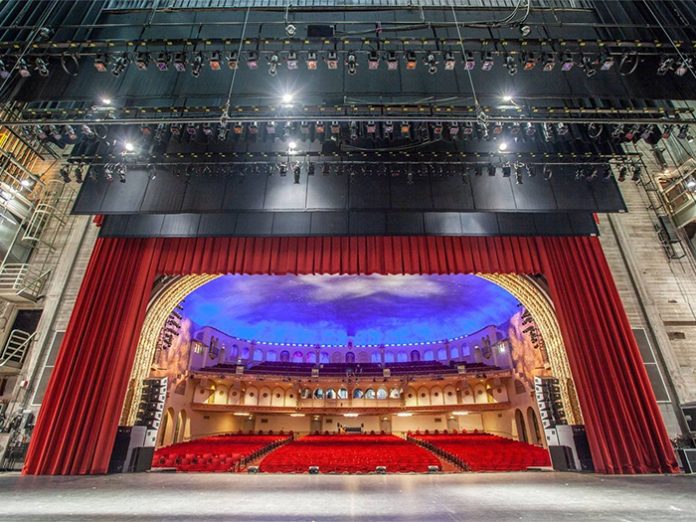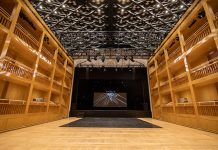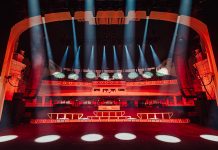The Orpheum Theatre is a 1,364-seat performance space located in downtown Phoenix, Arizona. If you’ve seen a performance of most any type – the Orpheum has likely seen it too.
Opened in 1929, the ornate, elaborate construction of the Orpheum was adorned within by magnificent murals and moldings that set the stage for Vaudeville and motion pictures. As Vaudeville died out, movies became the primary use – Paramount purchased the facility in the 1940s and used it as one of its motion picture houses through the 1960s. The Nederlander Organization then purchased the building to host traveling Broadway performances. In the 1970s a local family bought the location and hosted, primarily, Spanish-language performances and films. In the 1980s the venue branched out to live performance – and acts such as The Ramones, Metallica, Nirvana and REM played the venue as part of their tours.
It was then, in the 80s, when folks started to notice the venue had fallen into disrepair.
“It needed a lot of work after years of use for different performances,” said David Cruse, Theatrical Venues Manager at the City of Phoenix – the governing authority that oversees the Orpheum Theatre. “The proscenium arch had cutouts in it where a larger movie screen had been installed. The murals had been painted over with black paint so as not to detract from the film. Luckily, the citizens of Phoenix really took notice and asked the city to step in, which it did.”
The theatre underwent a $14 million renovation and reopened in 1997, with Carol Channing’s last performance of “Hello Dolly.” It has been in operation ever since.
However, the improvement of the Orpheum Theatre didn’t stop there.
“When I joined the team about three years ago I started speaking with the promoters in town and asked why they weren’t booking the Orpheum,” David said. “I wanted to know what wasn’t working and why they weren’t doing shows here. One answer that came up a lot was the poor audio.”
David said the sound system was “very dated.” When touring shows wanted to use the Orpheum they had to haul in their own gear – from speakers to consoles – because of the old technology.
“What we needed was a complete redesign of the audio from the ground up,” David said. “We needed it to be reliable and flexible so promoters knew they could rely on us. We also wanted it to be impressive to the point that those in the audience would walk away saying ‘that was amazing.’ For these reasons, we went with Dante.”
Dante is the de facto standard for digital audio networking, and distributes hundreds of
uncompressed digital channels audio via standard Ethernet networks, with near-zero latency and perfect synchronization. Dante allows audio and control data to coexist with
regular network data on the same network.
“Being able to use standard Ethernet networks and switches greatly reduces the cost and complexity of analog cabling,” said Dylan Dube, venue audio production coordinator for the Orpheum. “That was huge for us. Having the extra money that we normally would have spent on cabling go to other parts of the installation just makes the system that much better.”
“In April of 2019, we were able to put the full Dante network in place,” David said. “When we heard it for the first time it really did sound like the final piece was in place.”
The theatre currently boasts a completely redundant Dante network with a Yamaha Rivage PM7 at the front of it all. Of the 120 input channels, 96 channels are patched via Dante to three Yamaha 3224D-2 Rio I/O stage boxes through the building.
The theatre also has an ability to use Dante as a digital split snake by having two of Audinate’s HY144-SRC cards in the PM7. With the cards in place the theatre can use any of its other audio consoles (a Yamaha CL5 mixer, a Yamaha PM5D-RH mixer with 3 MY16-Aud2 cards, and an Allen & Heath SQ-5 with a Dante card) to control any position in the facility. All the devices are linked on the Dante network, meaning the system can be quickly reconfigured for individual user preference – such as monitor desk, recording or both.
The main PA system is fed from the Dante HY144D-SRC card in the Yamaha Rivage PM7 at a 96k sample rate. It is then converted in to AES3 using Dante AVIO Adapters.
Available for analogue input or output, for AES3 and USB conversion, Dante AVIO
Adapters allow users to connect their favourite audio gear with any Dante-connected
system — delivering the interoperability, performance, and scalability that only
networking can bring.
While the Dante-backed network provides the backbone for the system, Dante Domain Manager adds a level of observability, management and security that provides the Orpheum’s technicians with complete control.
Dante Domain Manager is network management software enabling user authentication, role-based security, and audit capabilities for Dante networks while allowing seamless expansion of Dante systems over any network infrastructure. Dante Domain Manager organizes a network into zones called “domains” that each have individual access requirements, making it clear and easy to know who can access any area of the system. All activity is logged, tagged, and date-stamped so problems can be quickly identified and solved.
“The ability to jump subnets is just fantastic,” Dylan said. “Our PA systems go from Dante on a DHCP network to our d&b audiotechnik network that is static. What Dante Domain Manager allows us to do is patch Dante to the static network only on channels we define. We’re jumping from DHCP to a static network in a way that is just immensely useful.”
Dylan also said setting guest domains has been great since the installation of the system. One example is when a guest engineer with a Dante enabled desk.
“We were able to let them plug directly into the switch,” Dylan said. “We asked what endpoints they wanted access to and we added those to the guest domain. They were up and running within the whole network within 10 minutes. At the same time, we kept control of their access. Dante Domain Manager removes any worry about inadvertent security or network compromises.”
David said when he looks at the full system he believes they have fulfilled a promise to city – to provide the best possible experience in the space. From a practical standpoint, the venue has become a jewel in the community.
“We want to be true to the history of the Orpheum,” David said. “We want to be known for variety. This means we absolutely needed top-quality audio, but also flexibility to bring all these events in. Dante means we can weave programming in and out easily and still know everyone is going to sound great in here.”





